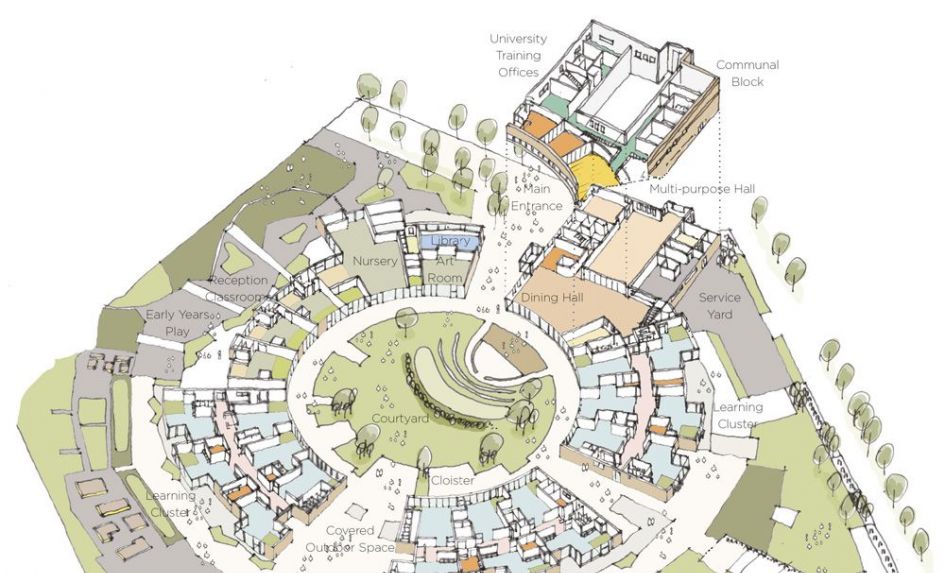How does one create a school where the philosophy of practice and architecture are aligned? What kind of building design suggests a thriving multi-generational democratic learning community that is inclusive, open and welcoming? With school research into these sort of questions in mind, The University of Cambridge Primary School (UCPS) was the first building to be completed on the site of the North West Cambridge Development (NWCD).
At capacity, the school houses over 700 children aged from 4 to 11 years of age. After a competitive process of bidding to build the school, Marks Barfield Architects was selected as the firm most attuned to the task of creating an environment that would respond dynamically to the needs of children and teachers, whilst also offering an open environment for those seeking to learn about transformative pedagogies. The Marks Barfield design team spent time carefully listening to advice given by Dame Alison Peacock, and asking questions about the educational vision.
21st-CENTURY LEARNING
The school’s design needed to reflect an open, inclusive pedagogy, as opposed to one that defined and designated certain areas for the majority and others for those labelled as having special needs. Trust was to be at the heart of a school that aimed to be non-hierarchical and highly democratic, where all children would be listened to and their views and preferences taken seriously. Experience shows that when children are trusted and know this, there is a positive impact on all aspects of their learning. It was therefore vital to ensure that both formal and informal opportunities could be easily created for dialogue to take place between children of all ages and adults. This might occur in the classroom, in shared areas, in the dining hall or outdoors in a range of spaces. It was intended that families and the wider community should be easily able to find their place in the school and that there should be built-in opportunities for dialogue and exchange – be it in a comfortable and calm dining area at lunch time, at the beginning or end of each day, or as part of celebrations and performances. Resisting notions of fixed ability, we were conscious that children of different ages would learn in close proximity to each other, offering the potential for younger children to be inspired by older children and for all children to support each other as a learning community. The aim was that learning should take place everywhere. Opportunities for children to surprise themselv es and others were to be optimised and enable liberating achievements.
A PROTECTIVE SPACE
It’s well recognised that outdoor environments are a significant resource in supporting play, learning and the vital opportunities for socialisation that all children need. It was therefore important that there should be easy access to the outdoors from each learning area – to encourage and enable the learning to spill out beyond the classroom, but also to ensure that children didn’t feel confined or boxed in. The decision to plant a wildwood and include running water, large rocks and a variety of planting emerged from the imperative to provide an outdoor environment that was free-flowing and non-sterile.
As a University Training School, the UCPS can expect high numbers of adult visitors whose presence shouldn’t impact on the children’s learning experience, thus necessitating spaces for formal professional learning activities such as seminars and lectures. The building also needed to provide access to the learning clusters without interrupting activities, by facilitating high visibility of the daily life of the school. This was achieved via the gallery and windows into the hall, but it was vital that neither teachers nor children should feel that they were trapped in an observation unit, so the decision was taken to imbue the entire building with the ethic of openness. It was intended that anyone visiting the school to study the children’s experience of primary education should be able to see this readily without disturbing the flow of learning. Children need to feel safe and secure in their schools. The broken circle of the UCPS buildings suggests a protective nurturing space. The school areas are not gated or restricted. Although the perimeter of the overall site is fenced, there are many spaces in the grounds that enable exploration. The articulated classrooms create a variety of flexible spaces for different types of learning activities, while nearby group rooms allow for individual and smaller group activities. The informal learning spaces in the shared learning streets are an extension of the classrooms. The inherent efficiency of a circle, combined with the principal circulation as an external glazed cloister, enabled the creation of a dining area and additional learning spaces – something not normally possible within the government’s area guidelines.










